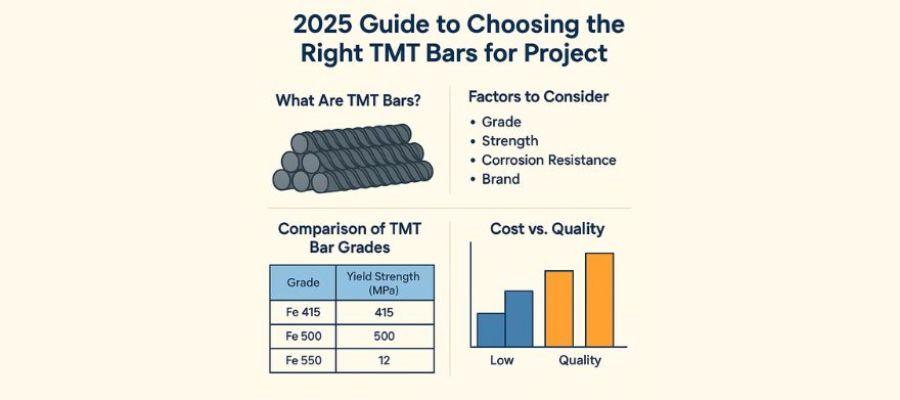Selecting the appropriate Thermo Mechanically Treated (TMT) bars is essential for construction in order to guarantee structural safety, longevity, and economy. The strength and longevity of your project will be directly impacted by the grade and quality of TMT bars, regardless of whether you're building an infrastructure project, a commercial complex, or a residential home.
This 2025 guide will help you understand the types, grades, and factors to consider before purchasing TMT bars, with handy tables and charts to make your decision easier.
1. What Are TMT Bars?
Steel reinforcement bars made using a special thermo-mechanical process are known as TMT bars. They are a popular option for building projects all over the world because of their exceptional tensile strength, superior bendability, and outstanding corrosion resistance.
2. Why TMT Bars Matter in Construction
- Strength & Safety – They provide the tensile strength required for structural integrity.
- Earthquake Resistance – Their ductility helps absorb seismic shocks.
- Corrosion Resistance – Essential for longevity in humid or coastal areas.
- Cost Efficiency – Proper grade selection can save unnecessary expenses without compromising quality.
3. TMT Bar Grades and Their Uses
TMT bars come in different grades, each with specific mechanical properties suitable for different types of projects.
Grade | Tensile Strength (MPa) | Elongation (%) | Best For |
Fe-415 | 485 | 14–15 | Small residential buildings |
Fe-500 | 545 | 12–13 | High-rise apartments, commercial buildings |
Fe-550 | 585 | 10–11 | Bridges, flyovers, heavy-duty construction |
Fe-600 | 615 | 8–9 | Mega infrastructure projects requiring high strength |
4. Chart: Strength Comparison of TMT Bar Grades
Below is a comparison of the tensile strength of popular TMT bar grades:
5. Key Factors to Consider Before Buying TMT Bars
a. Grade of TMT Bar
Choose a grade that matches the structural requirements of your project. For residential homes, Fe-415 or Fe-500 is common, while large-scale infrastructure may require Fe-550 or Fe-600.
b. Corrosion Resistance
If your project is in a coastal or humid area, opt for corrosion-resistant TMT bars with special anti-rust coatings.
c. Earthquake Resistance
Areas prone to seismic activity should use bars with higher ductility to withstand ground movement without breaking.
d. Certification & Quality Standards
Look for TMT bars that meet BIS (Bureau of Indian Standards) specifications and come from reputable manufacturers.
6. Comparison of Regular vs. Corrosion-Resistant TMT Bars
Feature | Regular TMT Bars | Corrosion-Resistant TMT Bars |
Durability | High | Very High |
Cost | Lower | Higher |
Ideal Use | General construction | Coastal, humid, or industrial areas |
Maintenance | Low | Very Low |
7. Tips for Cost-Effective Purchase
- Buy in bulk to negotiate better prices.
- Source directly from manufacturers or authorised dealers.
- Avoid counterfeit bars – always check for branding and BIS certification marks.
8. 2025 Trends in TMT Bar Selection
In 2025, buyers are focusing more on eco-friendly production, smart inventory tracking, and digitally verified supply chains. Many large projects are sourcing TMT bars through digital B2B marketplaces for faster procurement and quality assurance.

